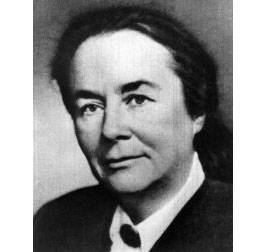 Zofia Kossak-Szczucka (1890-1968)
Zofia Kossak-Szczucka (1890-1968)Zofia Kossak-Szczucka (1890-1968) was a Polish author and a resistance fighter best known for her wartime efforts to help the Jews. She was a granddaughter of the Polish painter Juliusz. She married twice and kept the name Szczucka from her first marriage. Kossak-Szczucka was associated with the Czartak literary and wrote mainly for the Catholic press. Her best-known work from that period was ”Conflagration,” a memoir of the Russian Revolution.
During the occupation of Poland, Kossak-Szczucka worked for the underground press: from 1939 to 1941 she co-edited the underground newspaper Polska zyje (Poland Lives), and in 1941 she co-founded the Catholic organization, Front for the Rebirth of Poland. In 1941 she edited its paper Prawda (The Truth), using the code-name ”Weronika” (Veronica). Despite the Gestapo’s manhunt for her, she exposed herself to the added danger of helping the Jews.
Zofia’s motivation was moral, humanitarian, and patriotic. She regarded the Germans’ actions ”as an offense against man and God” and their policies as an affront to the ideals she espoused for an Independent Poland.
Wanda Krahelska-Filipowicz (1886-1968) was also not new to the Underground resistance activities. In 1906, during the time when Poland was still partitioned among Russia, Germany and Austria, she participated in a bombing attack on the Russian Governor-General of Warsaw.
Wanda was the wife of a former Ambassador to the United States and an editor of the art magazine Arkady. As a Socialist activist, she knew many people in the underground, including members of the Delegatura (the office of the Delegate of the Government-in-Exile and its military counterpart, the AK. Wanda used her influence to persuade both groups of the importance of setting up a central organization and to back it with large amounts of money. Using the code-name ”Alicja,” she began hiding Jews in her own home, one of whom was the widow of the Jewish historian, Szymon Aszkenazy.
Zofia was, by comparison, a Conservative nationalist. She was a well-known author and before the war, she was opposed to most Jewish groups and as a consequence, was considered anti-Semitic.
The idea of unifying the diverse efforts to help Jews was primarily the result of the efforts of these two women, Zofia Kossak-Szczucka and Wanda Krahelska-Filipowicz. Equally important was coordinating the efforts with the Jewish underground and establishing a liaison with the Jewish community.
By the summer of 1942, about a million of the Jews in Poland were dead from starvation, disease, and random massacres. That help to Jews had to be coordinated, organized on a larger scale and supported was undeniable. Certain death awaited them if they remained in the ghetto.
Zegota was an underground organization in German-occupied Poland from 1942 to 1945. It was founded as a continuation of an earlier committee, the Provisional Council to Aid the Jews, founded by Zofia Kossak and Wanda Krahelska.
In October, 1942, the Delegatura’s official newspaper, published the following:
”We have been asked to make it publicly known that the initiatives of a number of social organizations both Catholic and Democratic have led to the organization of the Civil Assistance Committee which will provide relief to the Jewish people suffering persecution. As far as means and opportunities allow and taking into account the living conditions of an occupied country, the Committee will try to bring relief to the victims of Nazi outrages.
This was the only public notice of the birth of Zegota.
Who was Konrad Zegota? In reality, there was no such person. In the Polish underground, there were code-names for everyone and everything. Zegota was the code-name for the Provisional Committee for Aid to Jews. Zegota immediately set to work to identify the most serious problem in rescue activities, to set up a plan of action and to recruit the people to implement them. Wanda Krahelska was well connected both to the military and political leaders of the Underground. And Zofia Kossak was to prove invaluable in locating homes for women and children because of her close ties to the Catholic clergy, as well as to the upper classes.
During the war, Zegota was the only underground organization that was run jointly by Jews and non-Jews from a wide range of political movements, and the only one, despite the arrests of some of its members, that was able to operate for a considerable length of time and to extend help to Jews in so many ways.
When the liquidation of the Warsaw Ghetto began in 1942, Zofia Kossak-Szczuka published a leaflet entitled ”Protest.” In it, she exhorted Poles, particularly those who felt antipathy toward the Jews before the war, to come to their assistance. After the war, she stated, Poles and Jews could resume their political and ideological fighting. For now, the only issue was a moral one.
The world, Kossak-Szczuka wrote, was silent in the face of this atrocity. ”England is silent, so is America, even the influential international Jewry, so sensitive in its reaction to any transgression against its people, is silent. Poland is silent… Those who are silent in the face of murder,” she wrote, ”become accomplices of the crime.”
In 1943, Kossak-Szczucka was arrested, but the Germans did not realize who she was. Zofia was sent first to the infamous Pawiak prison and then to Auschwitz. There, she was held in the work camp, not the adjacent extermination camp where Jews were sent. She was released through the efforts of the Polish underground and returned to Warsaw. In late 1944, she participated in the Warsaw Uprising. She survived that too. After the war she emigrated to Britain rather than live under the postwar Polish Communist regime.
References
- Zegota.
by Irene Tomaszewski and Tecia Werbowski.
Price-Patterson Ltd. Montreal, Canada.
© 1994-1999 - Zegota: The Council for Aid to Jews in Occupied Poland 1942-1945
- Wikipedia: Zegota
- Zegota. Non-Jewish Holocaust Victims – the 5 Million Forgotten
- Wikipedia: Zofia Kossak-Szczucka
- Protest of Zofia Kossak-Szczucka
